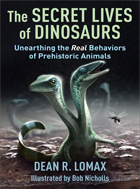Pronunciation: or-NITH-o-MIEM-uh-day
Author: O.C. Marsh
Year: 1890
Etymology: Bird-mimics (see etymology)
Locomotion: Bipedal (two legs)
Synonyms: Struthiomimidae (Osborn, 1972)
Author: O.C. Marsh
Year: 1890
Etymology: Bird-mimics (see etymology)
Locomotion: Bipedal (two legs)
Synonyms: Struthiomimidae (Osborn, 1972)
[Sereno 2005]Definition
The most inclusive clade containing Ornithomimus edmontonicus but not Garudimimus brevipes, Harpymimus okladnikovi, Shenzhousaurus orientalis and Pelecanimimus polyodon.
About
Ornithomimidae — literally "bird mimics" — are the advanced ornithomimosaurs. They are affectionately known as "ostrich dinosaurs" because of their medium build, long-necks, small-heads, large-eyes, toothless beaks and long powerful hindlimbs with "pinched" metatarsals that may have made them the fastest land-dwelling dinosaurs of all.
Although they sported long sloth-like forelimbs with huge curved claws, they were probably used for snagging branches on which to feed, and the sheer abundance of their remains in North America is consistant with the idea that they were plant eaters, as herbivores usually outnumber carnivores in an ecosystem.
The first ornithomimids appeared at the turn of the early cretaceous (99 mya ish) and the last of their kind were still tearing around North America and Asia right up to the very end of the age of dinosaurs. But they failed to outrun a six mile wide asteroid and when the dust settled they were just as extinct as every other non-avian dinosaur.
Click here to view Dinochecker's A-Z list of ornithomimids.
Etymology
Ornithomimidae is derived from the Greek "Ornith" (bird), "mimos" (mimic) and "-idae" (family), named for a group of dinosaurs closely related to Ornithomimus with features seen in modern, land-dwelling birds like emu and ostrich.
Relationships
References
• Chiappe LM, Norrell MA and Clark JM (2002) "Ornithomimosauria" in "Mesozoic Birds: Above the Heads of Dinosaurs". University of California Press.
• Ji Q, Norell MA, Makovicky PJ, Gao K, Ji S-A and Yuan C (2003) "An early ostrich dinosaur and implications for ornithomimosaur phylogeny". American Museum novitates, No. 3420.
• Barrett PM (March 2005) "The diet of ostrich dinosaurs (Theropoda: Ornithomimosauria)". Palaeontology, 48(2): 347-358.















